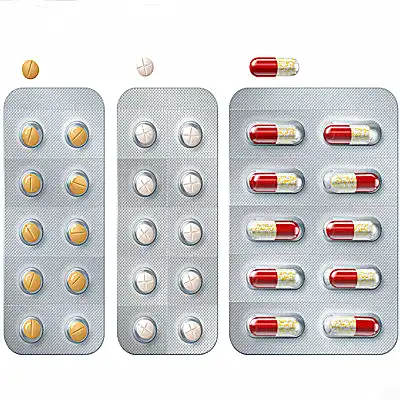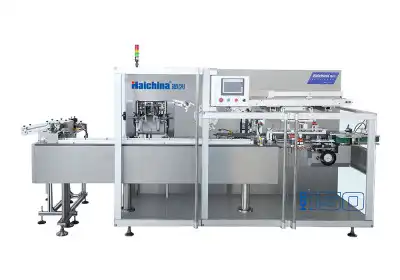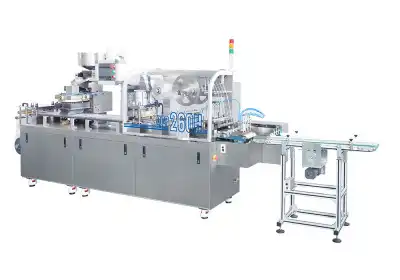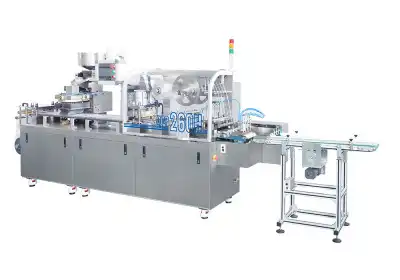Understanding Blister Packaging and Flow Pack Machines
Blister Packaging: Protective and Visually Appealing
Blister packaging, a staple in the pharmaceutical and consumer goods industries, involves sealing products between a pre-formed plastic cavity or "blister" and a backing material, typically cardboard or aluminum. This method offers excellent product visibility while providing a barrier against external factors. Blister packaging machines are designed to create these custom-fit packages efficiently, ensuring each product is securely sealed and protected.
Flow Pack Machines: Speed and Versatility
Flow pack machines, also known as horizontal form-fill-seal (HFFS) machines, create packages by forming a tube of film around a product, sealing it lengthwise, and then sealing and cutting the ends. These machines are renowned for their high-speed operation and ability to handle a wide range of product sizes and shapes. The continuous motion of flow pack machines makes them particularly suitable for high-volume production lines.
Comparing Sealing Mechanisms
The sealing mechanisms in blister packaging and flow pack machines differ significantly. Blister packaging typically uses heat sealing or cold sealing techniques to bond the blister to the backing material. Flow pack machines, conversely, employ various sealing methods including heat sealing, ultrasonic sealing, or cold sealing, depending on the packaging material and product requirements. Understanding these mechanisms is crucial for determining which option offers the most reliable seal for your specific application.
Factors Influencing Sealing Reliability
Material Compatibility
The choice of packaging material plays a pivotal role in sealing reliability. Blister packaging machines are typically designed to work with specific combinations of plastic and backing materials, ensuring optimal seal integrity. Flow pack machines offer more flexibility in material selection but require careful consideration to ensure compatibility between the film and sealing method. The right material choice can significantly enhance seal strength and durability.
Environmental Conditions
Environmental factors such as temperature, humidity, and exposure to light can impact sealing reliability. Blister packaging often provides superior protection against these elements, making it a preferred choice for moisture-sensitive products. Flow pack machines can also achieve hermetic seals, but the integrity may be more susceptible to environmental variations during the packaging process. Consideration of storage and transportation conditions is essential when evaluating sealing options.
Product Characteristics
The nature of the product being packaged significantly influences the choice between blister packaging and flow pack machines. Irregularly shaped items or those requiring individual protection often benefit from the custom-fit nature of blister packaging. Products with smooth surfaces or those packaged in large quantities may be more suitable for flow pack machines. The product's sensitivity to compression, moisture, and light should also guide the decision-making process.
Innovations in Sealing Technology
Advanced Blister Packaging Solutions
Recent advancements in blister packaging machine technology have focused on enhancing seal integrity and reducing material waste. Innovations such as radio frequency (RF) sealing and laser sealing offer improved precision and consistency in seal formation. These technologies allow for the creation of stronger, more reliable seals, particularly beneficial for pharmaceutical and medical device packaging where tamper-evidence and sterility are paramount.
Cutting-Edge Flow Pack Sealing
Flow pack machine manufacturers have made significant strides in improving sealing reliability. Ultrasonic sealing technology, for instance, provides stronger and more consistent seals while reducing energy consumption. Additionally, the integration of intelligent sealing systems that adjust parameters in real-time based on product and environmental conditions has greatly enhanced seal quality and consistency in flow pack operations.
Sustainable Sealing Solutions
As sustainability becomes increasingly important in packaging, both blister packaging and flow pack machine manufacturers are developing eco-friendly sealing solutions. This includes the use of biodegradable materials and sealing techniques that reduce energy consumption and material waste. These innovations not only improve environmental impact but often lead to more reliable and efficient sealing processes.
Conclusion
In the debate between blister packaging machine and flow pack machines for reliable sealing, there's no one-size-fits-all answer. Each method offers distinct advantages depending on the product, production requirements, and environmental considerations. Blister packaging excels in providing tamper-evident, highly protective seals for individual items, while flow pack machines offer high-speed, versatile packaging solutions with hermetic sealing capabilities. The choice ultimately depends on a careful evaluation of your specific needs, including product characteristics, production volume, and desired shelf life. As technology continues to advance, both methods are seeing improvements in sealing reliability, efficiency, and sustainability, offering manufacturers more options to meet their packaging needs.
FAQs
1. Which packaging method is more suitable for pharmaceutical products?
Blister packaging is often preferred for pharmaceuticals due to its tamper-evident nature and ability to protect individual doses.
2. Can flow pack machines handle irregularly shaped products?
Yes, modern flow pack machines can accommodate various product shapes, but extremely irregular items may be better suited for blister packaging.
3. Which method offers higher production speeds?
Generally, flow pack machines offer higher production speeds, making them ideal for high-volume packaging operations.
4. Are there eco-friendly options for both packaging methods?
Yes, both blister packaging and flow pack machines now offer sustainable options, including biodegradable materials and energy-efficient sealing technologies.
Expert Packaging Solutions | Haichina
At Haichina, we specialize in providing top-tier packaging solutions tailored to your specific needs. As a leading manufacturer and supplier of packaging equipment, we offer both blister packaging machines and flow pack machines designed for optimal sealing reliability. Our expert team can guide you through the selection process, ensuring you choose the perfect packaging solution for your products. With our commitment to innovation, quality, and customer satisfaction, we're your trusted partner in packaging excellence. For personalized advice or to discuss your packaging requirements, contact us at [email protected].
References
Johnson, M. (2022). "Advances in Pharmaceutical Packaging: Blister vs. Flow Pack." Journal of Packaging Technology and Research, 18(3), 245-260.
Smith, A. & Brown, L. (2021). "Comparative Analysis of Sealing Technologies in Modern Packaging Machines." International Journal of Industrial Engineering, 29(2), 178-195.
Lee, S. et al. (2023). "Environmental Impact Assessment of Blister and Flow Pack Packaging Methods." Sustainable Packaging Quarterly, 7(1), 32-48.
Garcia, R. (2022). "Innovations in Sealing Mechanisms for High-Speed Packaging Lines." Packaging Science and Technology, 14(4), 412-428.
Thompson, K. & Wilson, J. (2021). "Material Compatibility in Pharmaceutical Packaging: A Comprehensive Review." Drug Development and Industrial Pharmacy, 47(5), 601-618.
Zhang, Y. et al. (2023). "Sustainable Packaging Solutions: Balancing Performance and Environmental Impact." Journal of Cleaner Production, 375, 134806.





